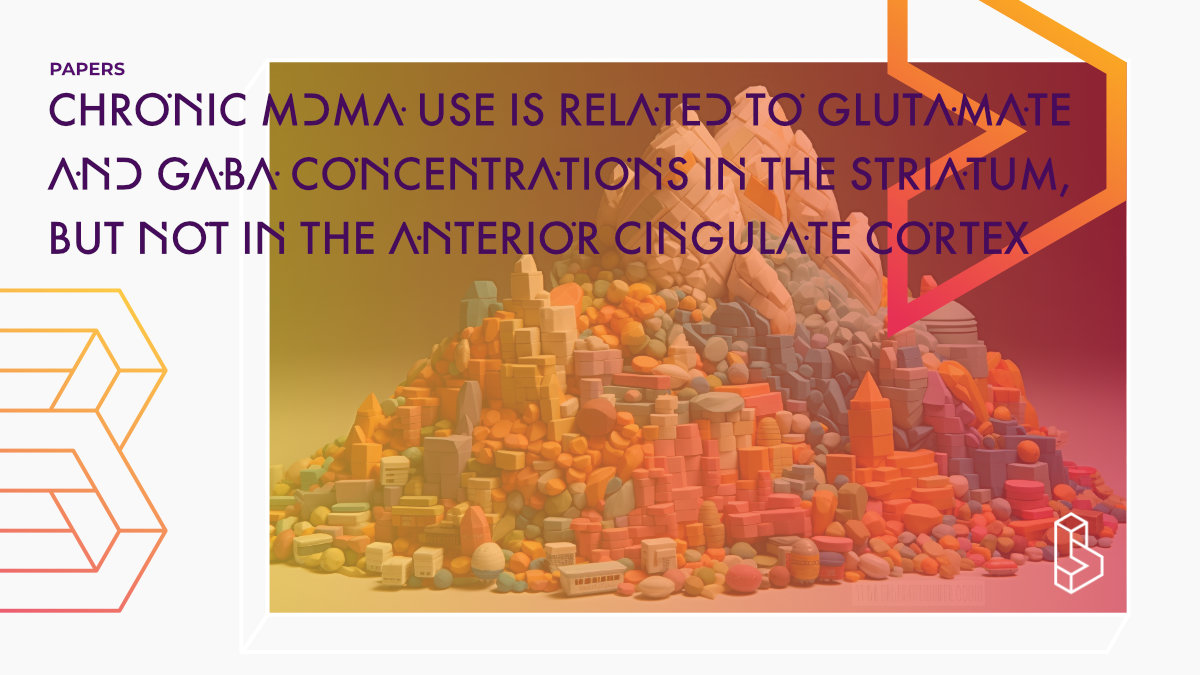This observational study (n=86) used proton magnetic resonance spectroscopy (MRS) to compare glutamate-glutamine complex (GLX) and γ-aminobutyric acid (GABA) concentrations in the brains of 44 chronic, but recently abstinent, MDMA users with 42 MDMA-naïve controls. The results showed elevated GLX levels in the striatum of MDMA users and no group differences in GABA concentrations, though a negative association with MDMA use frequency was found. These findings suggest that MDMA use affects not only serotonin but also striatum GLX and GABA concentrations, potentially offering new explanations for cognitive deficits observed in MDMA users.
Abstract of Chronic MDMA use is related to glutamate & GABA concentrations in the striatum, but not in the anterior cingulate cortex
“Background 3,4-Methylenedioxymethamphetamine (MDMA) is a widely used recreational substance inducing acute release of serotonin. Previous studies in chronic MDMA users demonstrated selective adaptations in the serotonin system, which were assumed to be associated with cognitive deficits. However, serotonin functions are strongly entangled with glutamate as well as γ-aminobutyric acid (GABA) neurotransmission, and studies in MDMA-exposed rats show long-term adaptations in glutamatergic and GABAergic signaling.
Methods We used proton magnetic resonance spectroscopy (MRS) to measure the glutamate-glutamine complex (GLX) and GABA concentrations in the left striatum and medial anterior cingulate cortex (ACC) of 44 chronic but recently abstinent MDMA users and 42 MDMA-naïve healthy controls. While the Mescher-Garwood point-resolved-spectroscopy sequence (MEGA-PRESS) is best suited to quantify GABA, recent studies reported poor agreement between conventional short–echo-time PRESS and MEGA-PRESS for GLX measures. Here, we applied both sequences to assess their agreement and potential confounders underlying the diverging results.
Results Chronic MDMA users showed elevated GLX levels in the striatum but not the ACC. Regarding GABA, we found no group difference in either region, although a negative association with MDMA use frequency was observed in the striatum. Overall, GLX measures from MEGA-PRESS, with its longer echo time, appeared to be less confounded by macromolecule signal than the short–echo-time PRESS and thus provided more robust results.
Conclusion Our findings suggest that MDMA use affects not only serotonin but also striatal GLX and GABA concentrations. These insights may offer new mechanistic explanations for cognitive deficits (e.g., impaired impulse control) observed in MDMA users.”
Authors: Josua Zimmermann, Niklaus Zölch, Rebecca Coray, Francesco Bavato, Nicole Friedli, Markus R. Baumgartner, Andrea E. Steuer, Antje Opitz, Annett Werner, Georg Oeltzschner, Erich Seifritz, Ann-Kathrin Stock, Christian Beste, David M. Cole & Boris B. Quednow
Find this paper
https://doi.org/10.1093/ijnp/pyad023
Open Access | Google Scholar | Backup | 🕊
Cite this paper (APA)
Zimmermann, J., Zölch, N., Coray, R., Bavato, F., Friedli, N., Baumgartner, M. R., ... & Quednow, B. B. (2023). Chronic 3, 4-Methylenedioxymethamphetamine (MDMA) use is related to glutamate and GABA concentrations in the striatum, but not in the anterior cingulate cortex. International Journal of Neuropsychopharmacology, pyad023.
Study details
Compounds studied
MDMA
Topics studied
Safety
Neuroscience
Study characteristics
Bio/Neuro
Participants
86
Humans

